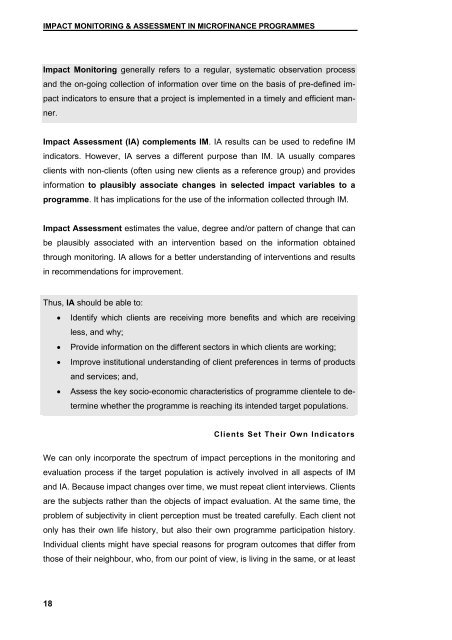Guidelines for Impact Monitoring & Assessment in Microfinance ...
Guidelines for Impact Monitoring & Assessment in Microfinance ...
Guidelines for Impact Monitoring & Assessment in Microfinance ...
Create successful ePaper yourself
Turn your PDF publications into a flip-book with our unique Google optimized e-Paper software.
IMPACT MONITORING & ASSESSMENT IN MICROFINANCE PROGRAMMES<br />
<strong>Impact</strong> <strong>Monitor<strong>in</strong>g</strong> generally refers to a regular, systematic observation process<br />
and the on-go<strong>in</strong>g collection of <strong>in</strong><strong>for</strong>mation over time on the basis of pre-def<strong>in</strong>ed im-<br />
pact <strong>in</strong>dicators to ensure that a project is implemented <strong>in</strong> a timely and efficient man-<br />
ner.<br />
<strong>Impact</strong> <strong>Assessment</strong> (IA) complements IM. IA results can be used to redef<strong>in</strong>e IM<br />
<strong>in</strong>dicators. However, IA serves a different purpose than IM. IA usually compares<br />
clients with non-clients (often us<strong>in</strong>g new clients as a reference group) and provides<br />
<strong>in</strong><strong>for</strong>mation to plausibly associate changes <strong>in</strong> selected impact variables to a<br />
programme. It has implications <strong>for</strong> the use of the <strong>in</strong><strong>for</strong>mation collected through IM.<br />
<strong>Impact</strong> <strong>Assessment</strong> estimates the value, degree and/or pattern of change that can<br />
be plausibly associated with an <strong>in</strong>tervention based on the <strong>in</strong><strong>for</strong>mation obta<strong>in</strong>ed<br />
through monitor<strong>in</strong>g. IA allows <strong>for</strong> a better understand<strong>in</strong>g of <strong>in</strong>terventions and results<br />
<strong>in</strong> recommendations <strong>for</strong> improvement.<br />
Thus, IA should be able to:<br />
18<br />
• Identify which clients are receiv<strong>in</strong>g more benefits and which are receiv<strong>in</strong>g<br />
less, and why;<br />
• Provide <strong>in</strong><strong>for</strong>mation on the different sectors <strong>in</strong> which clients are work<strong>in</strong>g;<br />
• Improve <strong>in</strong>stitutional understand<strong>in</strong>g of client preferences <strong>in</strong> terms of products<br />
and services; and,<br />
• Assess the key socio-economic characteristics of programme clientele to de-<br />
term<strong>in</strong>e whether the programme is reach<strong>in</strong>g its <strong>in</strong>tended target populations.<br />
Clients Set Their Own Indicators<br />
We can only <strong>in</strong>corporate the spectrum of impact perceptions <strong>in</strong> the monitor<strong>in</strong>g and<br />
evaluation process if the target population is actively <strong>in</strong>volved <strong>in</strong> all aspects of IM<br />
and IA. Because impact changes over time, we must repeat client <strong>in</strong>terviews. Clients<br />
are the subjects rather than the objects of impact evaluation. At the same time, the<br />
problem of subjectivity <strong>in</strong> client perception must be treated carefully. Each client not<br />
only has their own life history, but also their own programme participation history.<br />
Individual clients might have special reasons <strong>for</strong> program outcomes that differ from<br />
those of their neighbour, who, from our po<strong>in</strong>t of view, is liv<strong>in</strong>g <strong>in</strong> the same, or at least

















![CynefinFramework final [Read-Only]](https://img.yumpu.com/19017304/1/190x135/cynefinframework-final-read-only.jpg?quality=85)